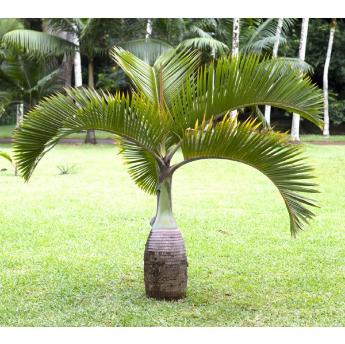Live Green, Love Green, Think Green
South Florida Landscape Plants
| Bottle Palm Hyophorbe lagenicaulis The bottle palm, aptly named for its uniquely shaped trunk, is happiest in the warmer areas of South Florida. Bottle palm in a front yard bed Though it can be cold-sensitive, this palm is an outstanding accent palm for tropical garden beds or sheltered entry areas. Its small size and striking appearance enhance formal or eclectic landscapes. The fronds are few but long and graceful. And the crownshaft (the area above the trunk) and leaf stems (petioles) have an attractive reddish color that fades as the palm slowly matures. Most often seen as a single specimens, bottle palms are also available as novel, eye-catching multi-trunk specimens, usually with 2 or 3 trunks. Young palm with reddish color Contrary to popular belief, the swollen trunk of this mini palm tree is not for water storage. Though it can be moderately drought-tolerant once it's established, this palm does need regular irrigation during dry spells. Plant specs Bottles are slow growing palms that could end up about 10 feet at maturity...but maturity takes many, many years. Most specimens in the landscape average only 5 to 7 feet tall. Cold is a very real threat, so growing in Zone 10B - especially in warmer coastal areas - is fine for normal winter temperatures. In Zone 10A plant in a sheltered location and be prepared to protect the palm from cold (see Plant Care below). Bottles are drought-tolerant and like full to part sun locations. They can be used in partial shade as well, but if there's too much shade the crownshaft will grow elongated and lean toward the light - turning unique into just plain ugly. These palms are highly salt-tolerant making them ideal for coastal plantings. Plant care Plant in an area where the soil drains well, like a beach environment. This palm does not like an overly wet area. Add top soil to the hole when you plant. Bottles aren't self-cleaning but, due to their slow growth rate, you'll rarely have to trim off an old frond. In a corner lot garden Freezing or sub-freezing temperatures can kill a bottle palm tree. For cold protection, tie up the fronds and wrap the entire head of the palm with frost cloth or a thick blanket. If the cold weather damages any fronds, resist the urge to to trim them until winter is over. Damaged fronds will usually bear the brunt of future cold weather, protecting the rest of the palm. This is not a hungry palm, so fertilizing with a slow-release granular three times a year - once a season in spring, summer and autumn - is plenty. Bottles are fairly drought-tolerant once established, though a regular watering keeps them looking their best. |

